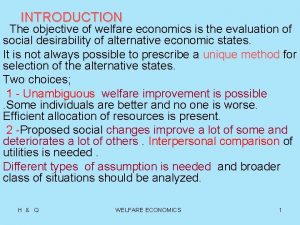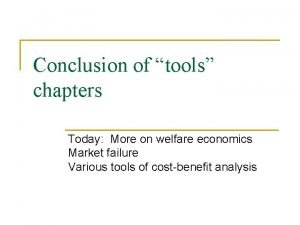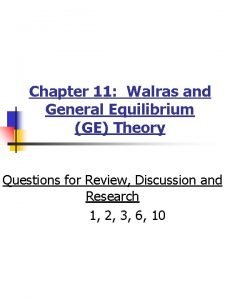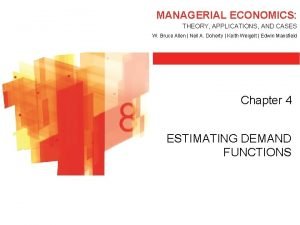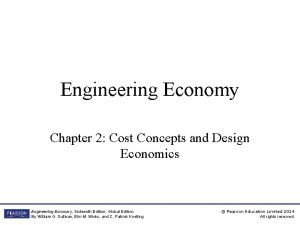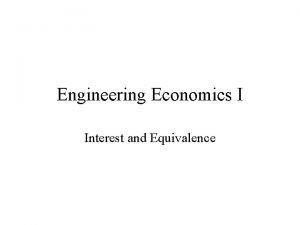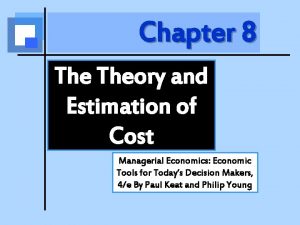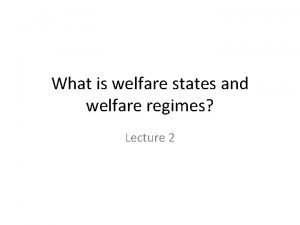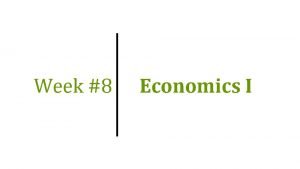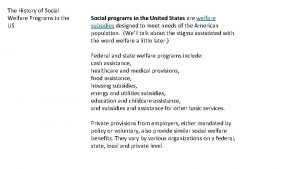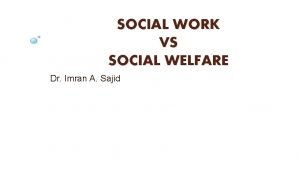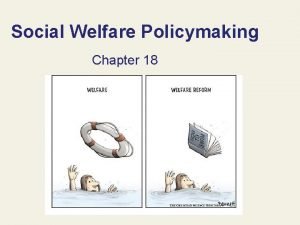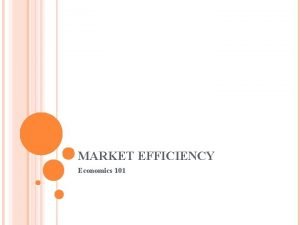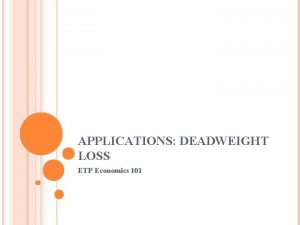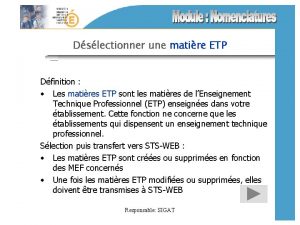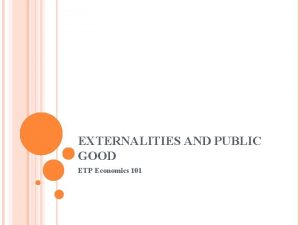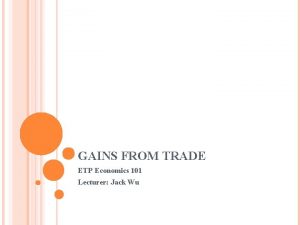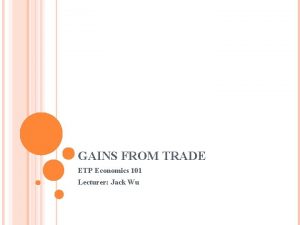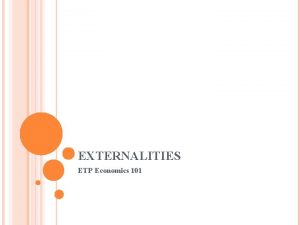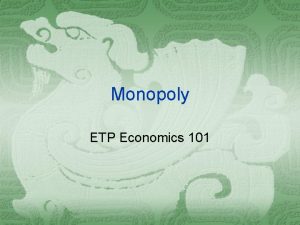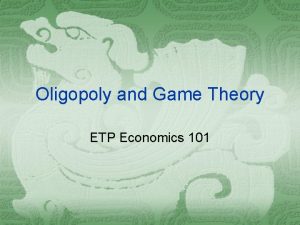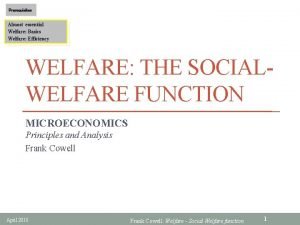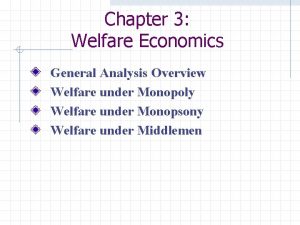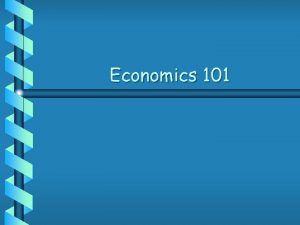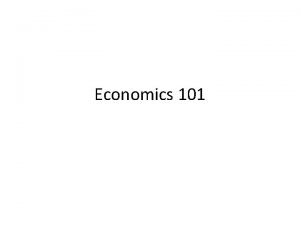APPLICATIONS OF WELFARE ETP Economics 101 TOPICS Cost
























































- Slides: 56

APPLICATIONS OF WELFARE ETP Economics 101

TOPICS Cost of Taxation International Trade

COST OF TAXATION

DEADWEIGHT LOSS Changes in Welfare A deadweight loss is the fall in total surplus that results from a market distortion, such as government regulations on prices and tax.

TAX ON A GOOD Levied on buyers Demand curve shifts downward by the size of tax Levied on sellers Supply curve shifts upward by the size of tax Same outcome: price wedge Price paid by buyers – rises Price received by sellers – falls Lower quantity sold

TAX ON A GOOD-CONTINUED Tax burden Distributed between producers and consumers Determined by elasticities of supply and demand Market for the good - smaller

The effects of a tax Price Supply Price buyers pay Price without tax Size of tax Price sellers receive Demand 0 Quantity with tax Quantity without tax Quantity A tax on a good places a wedge between the price that buyers pay and the price that sellers receive. The quantity of the good sold falls. 7

TAX WEDGE A tax places a wedge between the price buyers pay and the price sellers receive. Because of this tax wedge, the quantity sold falls below the level that would be sold without a tax. The size of the market for that good shrinks.

THE DEADWEIGHT LOSS OF TAXATION How a tax affects market participants Gains and losses from a tax on a good consumer surplus Sellers: producer surplus Government: total tax revenue Tax times quantity sold Public benefit from the tax 9 Buyers:

FIGURE 2 TAX REVENUE Price Supply Price buyers pay Size of tax (T) Tax revenue (T × Q) Price sellers receive Demand Quantity sold (Q) 0 Quantity with tax Quantity without tax Quantity Copyright © 2004 South-Western

HOW A TAX AFFECTS WELFARE Price buyers pay =PB Price without=P 1 tax Price =PS sellers receive Supply A B C E D F 0 Consumer Surplus Producer Surplus Tax Revenue Total Surplus Demand Q 2 Q 1 A tax on a good reduces consumer surplus (by the area B + C) and producer surplus (by the area D + E). Because the fall in producer and consumer surplus exceeds tax revenue (area B + D), the tax is said to impose a deadweight loss (area C + E). Quantity Without Tax With Tax Change A+B+C D+E+F None A+B+C+D+E+F A F B+D A+B+D+F -(B+C) -(D+E) +(B+D) -(C+E) The area C + E shows the fall in total surplus and is the deadweight loss of the tax 11

THE DEADWEIGHT LOSS OF TAXATION Losses of surplus to buyers and sellers from a tax the revenue raised by the government Deadweight loss Fall in total surplus that results from a market distortion, such as a tax Taxes distort incentives Markets allocate resources inefficiently 12 Exceed

DETERMINANTS OF DEADWEIGHT LOSS What determines whether the deadweight loss from a tax is large or small? The magnitude of the deadweight loss depends on how much the quantity supplied and quantity demanded respond to changes in the price. That, in turn, depends on the price elasticities of supply and demand.

DETERMINANTS OF DEADWEIGHT LOSS The greater the elasticities of demand supply: the larger will be the decline in equilibrium quantity and, the greater the deadweight loss of a tax.

FIGURE 5 TAX DISTORTIONS AND ELASTICITIES (a) Inelastic Supply Price Supply When supply is relatively inelastic, the deadweight loss of a tax is small. Size of tax Demand 0 Quantity Copyright © 2004 South-Western

FIGURE 5 TAX DISTORTIONS AND ELASTICITIES (b) Elastic Supply Price When supply is relatively elastic, the deadweight loss of a tax is large. Size of tax Supply Demand 0 Quantity Copyright © 2004 South-Western

FIGURE 5 TAX DISTORTIONS AND ELASTICITIES (c) Inelastic Demand Price Supply Size of tax When demand is relatively inelastic, the deadweight loss of a tax is small. Demand 0 Quantity Copyright © 2004 South-Western

FIGURE 5 TAX DISTORTIONS AND ELASTICITIES (d) Elastic Demand Price Supply Size of tax Demand When demand is relatively elastic, the deadweight loss of a tax is large. 0 Quantity Copyright © 2004 South-Western

DEADWEIGHT LOSS AND TAX RATE With each increase in the tax rate, the deadweight loss of the tax rises even more rapidly than the size of the tax.

TAX REVENUE AND TAX RATE For the small tax, tax revenue is small. As the size of the tax rises, tax revenue grows. But as the size of the tax continues to rise, tax revenue falls because the higher tax reduces the size of the market.

FIGURE 6 DEADWEIGHT LOSS AND TAX REVENUE FROM THREE TAXES OF DIFFERENT SIZES (a) Small Tax Price Deadweight loss Supply PB Tax revenue PS Demand 0 Q 2 Q 1 Quantity Copyright © 2004 South-Western

FIGURE 6 DEADWEIGHT LOSS AND TAX REVENUE FROM THREE TAXES OF DIFFERENT SIZES (b) Medium Tax Price Deadweight loss PB Supply Tax revenue PS 0 Demand Q 2 Q 1 Quantity Copyright © 2004 South-Western

FIGURE 6 DEADWEIGHT LOSS AND TAX REVENUE FROM THREE TAXES OF DIFFERENT SIZES (c) Large Tax Price PB Tax revenue Deadweight loss Supply Demand PS 0 Q 2 Q 1 Quantity Copyright © 2004 South-Western

FIGURE 7 HOW DEADWEIGHT LOSS AND TAX REVENUE VARY WITH THE SIZE OF A TAX Deadweight Loss 0 Tax Size Copyright © 2004 South-Western

FIGURE 7 HOW DEADWEIGHT LOSS AND TAX REVENUE VARY WITH THE SIZE OF A TAX Tax Revenue 0 Tax Size Copyright © 2004 South-Western

DEADWEIGHT LOSS & TAX REVENUE AS TAXES VARY As the tax increases loss increases Even more rapidly than the size of the tax Tax revenue Increases initially Then decreases Higher tax – drastically reduces the size of the market 26 Deadweight

LAFFER CURVE AND SUPPLY-SIDE ECONOMICS The Laffer curve depicts the relationship between tax rates and tax revenue. Supply-side economics refers to the views of Reagan and Laffer who proposed that a tax cut would induce more people to work and thereby have the potential to increase tax revenues.

INTERNATIONAL TRADE

EQUILIBRIUM WITHOUT TRADE Equilibrium Without Trade Assume: A country is isolated from rest of the world and produces steel. The market for steel consists of the buyers and sellers in the country. No one in the country is allowed to import or export steel.

FIGURE 1 THE EQUILIBRIUM WITHOUT INTERNATIONAL TRADE Price of Steel Domestic supply Consumer surplus Equilibrium price Producer surplus Domestic demand 0 Equilibrium quantity Quantity of Steel Copyright © 2004 South-Western

IMPORTER OR EXPORTER? If the country decides to engage in international trade, will it be an importer or exporter of steel? The effects of free trade can be shown by comparing the domestic price of a good without trade and the world price of the good. The world price refers to the price that prevails in the world market for that good.

EXPORTER If a country has a comparative advantage, then the domestic price will be below the world price, and the country will be an exporter of the good.

FIGURE 2 INTERNATIONAL TRADE IN AN EXPORTING COUNTRY Price of Steel Domestic supply Price after trade World price Price before trade Exports 0 Domestic quantity demanded Domestic demand Domestic quantity supplied Quantity of Steel Copyright © 2004 South-Western

FIGURE 3 HOW FREE TRADE AFFECTS WELFARE IN AN EXPORTING COUNTRY Price of Steel Price after trade Exports A B Price before trade D Domestic supply World price C Domestic demand 0 Quantity of Steel Copyright © 2004 South-Western

FIGURE 3 HOW FREE TRADE AFFECTS WELFARE IN AN EXPORTING COUNTRY Price of Steel Price after trade Consumer surplus before trade Domestic supply Exports A B Price before trade D C Producer surplus before trade 0 World price Domestic demand Quantity of Steel Copyright © 2004 South-Western

WINNERS AND LOSERS The analysis of an exporting country yields two conclusions: Domestic producers of the good are better off, and domestic consumers of the good are worse off. Trade raises the economic well-being of the nation as a whole.

IMPORTER If the country does not have a comparative advantage, then the domestic price will be higher than the world price, and the country will be an importer of the good.

FIGURE 4 INTERNATIONAL TRADE IN AN IMPORTING COUNTRY Price of Steel Domestic supply Price before trade Price after trade 0 World price Domestic Imports demand Quantity Domestic of Steel quantity supplied demanded Copyright © 2004 South-Western

FIGURE 5 HOW FREE TRADE AFFECTS WELFARE IN AN IMPORTING COUNTRY Price of Steel Domestic supply A Price before trade Price after trade C B D Imports World price Domestic demand 0 Quantity of Steel Copyright © 2004 South-Western

FIGURE 5 HOW FREE TRADE AFFECTS WELFARE IN AN IMPORTING COUNTRY Price of Steel Consumer surplus before trade Domestic supply A Price before trade B Price after trade C World price Producer surplus before trade 0 Domestic demand Quantity of Steel Copyright © 2004 South-Western

FIGURE 5 HOW FREE TRADE AFFECTS WELFARE IN AN IMPORTING COUNTRY Price of Steel Consumer surplus after trade Domestic supply A Price before trade Price after trade C 0 B D Imports Producer surplus after trade World price Domestic demand Quantity of Steel Copyright © 2004 South-Western

WINNERS AND LOSERS How Free Trade Affects Welfare in an Importing Country The analysis of an importing country yields two conclusions: Domestic producers of the good are worse off, and domestic consumers of the good are better off. Trade raises the economic well-being of the nation as a whole because the gains of consumers exceed the losses of producers

TARIFF A tariff is a tax on goods produced abroad and sold domestically. Tariffs raise the price of imported goods above the world price by the amount of the tariff.

FIGURE 6 THE EFFECTS OF A TARIFF Price of Steel Domestic supply Equilibrium without trade Price with tariff Tariff Price without tariff 0 Imports with tariff S Q S Domestic demand D Q Q Imports without tariff D Q World price Quantity of Steel Copyright © 2004 South-Western

FIGURE 6 THE EFFECTS OF A TARIFF Price of Steel Consumer surplus before tariff Producer surplus before tariff Domestic supply Equilibrium without trade Price without tariff 0 Domestic demand S D Q Q Imports without tariff World price Quantity of Steel Copyright © 2004 South-Western

FIGURE 6 THE EFFECTS OF A TARIFF Price of Steel Consumer surplus with tariff A Domestic supply Equilibrium without trade B Price with tariff Tariff Price without tariff 0 Imports with tariff S Q S Domestic demand D Q Q Imports without tariff D Q World price Quantity of Steel Copyright © 2004 South-Western

FIGURE 6 THE EFFECTS OF A TARIFF Price of Steel Domestic supply Producer surplus after tariff Price with tariff Equilibrium without trade Tariff C Price without tariff. G 0 Imports with tariff S Q S Domestic demand D Q Q Imports without tariff D Q World price Quantity of Steel Copyright © 2004 South-Western

FIGURE 6 THE EFFECTS OF A TARIFF Price of Steel Domestic supply Tariff Revenue Price with tariff E Price without tariff 0 Tariff Imports with tariff S Q S Domestic demand D Q Q Imports without tariff D Q World price Quantity of Steel Copyright © 2004 South-Western

FIGURE 6 THE EFFECTS OF A TARIFF Price of Steel Domestic supply A Deadweight Loss B Price with tariff C D Price without tariff. G 0 E Tariff F Imports with tariff S Q S Domestic demand D Q Q Imports without tariff D Q World price Quantity of Steel Copyright © 2004 South-Western

EFFECTS OF TARIFF A tariff reduces the quantity of imports and moves the domestic market closer to its equilibrium without trade. With a tariff, total surplus in the market decreases by an amount referred to as a deadweight loss.

IMPORT QUOTA An import quota is a limit on the quantity of a good that can be produced abroad and sold domestically.

FIGURE 7 THE EFFECTS OF AN IMPORT QUOTA Price of Steel Domestic supply Equilibrium without trade Quota Isolandian price with quota Equilibrium with quota Price World without= price quota 0 Domestic supply + Import supply Imports with quota S Q Domestic demand D Q Imports without quota D Q World price Quantity of Steel Copyright © 2004 South-Western

EFFECTS OF IMPORT QUOTA Because the quota raises the domestic price above the world price, domestic buyers of the good are worse off, and domestic sellers of the good are better off. License holders are better off because they make a profit from buying at the world price and selling at the higher domestic price.

FIGURE 7 THE EFFECTS OF AN IMPORT QUOTA Price of Steel Domestic supply Equilibrium without trade Quota A Isolandian price with quota Price World without= price G quota 0 B C E' D Equilibrium with quota F E" Imports with quota S Q Domestic supply + Import supply Domestic demand D Q Imports without quota D Q World price Quantity of Steel Copyright © 2004 South-Western

DEADWEIGHT LOSS OF QUOTA With a quota, total surplus in the market decreases by an amount referred to as a deadweight loss. The quota can potentially cause an even larger deadweight loss, if a mechanism such as lobbying is employed to allocate the import licenses.

LESSONS FROM TRADE POLICY Both tariffs and import quotas. . . raise domestic prices. reduce the welfare of domestic consumers. increase the welfare of domestic producers. cause deadweight losses.
 Etp presentation
Etp presentation Etp pharmacy
Etp pharmacy California etp program
California etp program Objectives of welfare economics
Objectives of welfare economics Conclusion of welfare economics
Conclusion of welfare economics Father of welfare economics
Father of welfare economics Social solidarity meaning
Social solidarity meaning Business economics topics
Business economics topics Managerial economics: theory, applications, and cases
Managerial economics: theory, applications, and cases Managerial economics applications strategy and tactics
Managerial economics applications strategy and tactics Maastricht university school of business and economics
Maastricht university school of business and economics Elements of mathematical economics
Elements of mathematical economics Cost estimation in managerial economics
Cost estimation in managerial economics Egn 3615
Egn 3615 Cost in economics
Cost in economics Engineering economy chapter 2 solutions
Engineering economy chapter 2 solutions Capitalized cost formula engineering economics
Capitalized cost formula engineering economics Estimation of cost function in managerial economics
Estimation of cost function in managerial economics Cost accumulation and cost assignment
Cost accumulation and cost assignment Cost accumulation and cost assignment
Cost accumulation and cost assignment Manufacturing cost vs non manufacturing cost
Manufacturing cost vs non manufacturing cost Manufacturing cost vs non manufacturing cost
Manufacturing cost vs non manufacturing cost Floatation cost
Floatation cost Uncontrollable cost example
Uncontrollable cost example Cost pools
Cost pools Manufacturing cost vs non manufacturing cost
Manufacturing cost vs non manufacturing cost Standard costing and variance analysis
Standard costing and variance analysis Opportunity cost of equity capital
Opportunity cost of equity capital Cost accumulation and cost assignment
Cost accumulation and cost assignment Cost control and cost reduction difference
Cost control and cost reduction difference Standard cost
Standard cost Literal cost gate input cost
Literal cost gate input cost Distinguish between average cost and marginal cost
Distinguish between average cost and marginal cost Cost control and cost reduction difference
Cost control and cost reduction difference Job order cost system vs process cost system
Job order cost system vs process cost system Ordering cost and carrying cost
Ordering cost and carrying cost Literal cost gate input cost
Literal cost gate input cost Literal cost gate input cost
Literal cost gate input cost Actual cost and opportunity cost
Actual cost and opportunity cost Cost control and cost reduction project report
Cost control and cost reduction project report Cost control and cost reduction project report
Cost control and cost reduction project report The relative proportion of variable fixed or mixed
The relative proportion of variable fixed or mixed What is welfare
What is welfare What is welfare
What is welfare Cdm welfare facilities
Cdm welfare facilities Deadweight loss in a monopoly
Deadweight loss in a monopoly Vhwo
Vhwo Tijana grujic
Tijana grujic Welfare programs in the us
Welfare programs in the us Social welfare vs social work
Social welfare vs social work Social welfare programs
Social welfare programs Industrial achievement performance model
Industrial achievement performance model Lta welfare officer poster
Lta welfare officer poster Guardian delta
Guardian delta National program related to child health and welfare ppt
National program related to child health and welfare ppt National policy and legislation related to child health
National policy and legislation related to child health Deadweight loss monopoly graph
Deadweight loss monopoly graph



